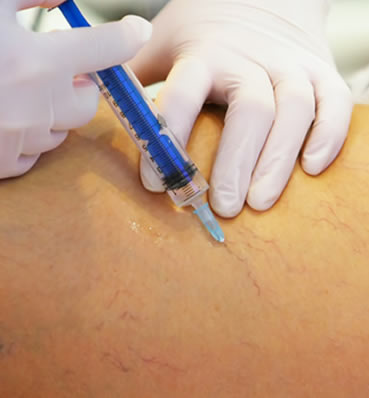
Saturday and Sunday - CLOSED

Longwood, Fl 32779

Sclerotherapy is used to treat spider veins and sometimes small varicose veins. The vein is injected with a sclerosing agent using a very fine needle. This chemical compound causes the blood vessel to close up and eventually disappear. The procedure is virtually painless, and most patients report feeling only a slight tingling or burning sensation. While sclerotherapy does not provide a complete elimination of the problem veins, the majority of patients experience very good results. Some patients do report poor results, and in rare cases the patient’s condition has worsened after treatment. If the vein is not located near the surface of the leg, it may be necessary to use Ultrasound Guided Sclerotherapy.
To find out whether sclerotherapy is right for you, call or contact Heart Vein & Vascular today to schedule a consultation
RISKS / SIDE EFFECTS of SCLEROTHERAPY
The most common side effects experienced with sclerotherapy treatment include but are not limited to:
TRANSIENT HYPERPIGMENTATION: Approximately 15% of patients who undergo sclerotherapy notice a discoloration (light brown streaks) after treatment. This usually fades in 4 to 12 months. In rare instances this darkening of the skin may persist for years.
SLOUGHING: This occurs in less than 1% of patients who receive sclerotherapy. Sloughing consists of an ulceration near the injection site that heals slowly over a few months. A blister may form, break open, and become ulcerated which may or may not leave a scar.
ALLERGIC REACTIONS: Very rarely a patient may have an allergic reaction to the sclerosing agent. The most common allergic reaction is hives, usually occurring during the treatment session, although a life threatening reaction can always occur.
PAIN: A few patients may experience moderate pain usually at the site of the injection. The veins may be tender to the touch after treatment, and an uncomfortable sensation may run along the vein route. This discomfort is temporary.
TELANGIECTATIC MATTING: This refers to the development of new very fine blood vessels in the area of the treated vein. This phenomenon occurs 2 to 4 weeks after treatment and usually resolves within 4 to 6 months. It occurs in up to 20% of women receiving estrogen therapy and in 2% to 4% of all patients.
ANKLE/LEG SWELLING: This may occur after treating veins in the lower leg. It usually resolves in a few days but may last a few weeks, especially after treatment of varicose veins. Ankle swelling is lessened by wearing the prescribed support/compression stockings.
DEEP VEIN PHLEBITIS: This is a very rare complication seen in approximately 1 out of every 10,000 patients treated. The dangers of phlebitis include the possibility of pulmonary embolus (a blood clot carried to the lungs) and post phlebitic syndrome (permanent swelling of the leg). In most cases eliminating varicose veins actually decreases the risk for deep vein phlebitis.
Sclerotherapy Preparation:
•Avoid caffeine for 24 hours prior to the procedure.
•Do not wear compression stockings for 24 hours before the procedure, but be sure to bring them with you.
Copyright 2024. All rights reserved.